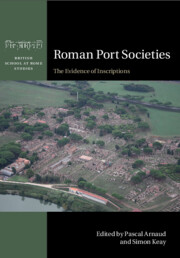Book contents
- Roman Port Societies
- British School at Rome Studies
- Roman Port Societies
- Copyright page
- Contents
- Figures
- Tables
- Contributors
- Abbreviations
- 1 The Context of Roman Mediterranean Port Societies
- 2 Inscriptions and Port Societies
- 3 Stationes and Associations of Merchants at Puteoli and Delos
- 4 Boatmen and their Corpora in the Great Ports of the Roman West (Second to Third Centuries AD)
- 5 Roman Port Societies and Their Collegia
- 6 Port Occupations and Social Hierarchies
- 7 Warehouse Societies
- 8 The Imperial Cult and the Sacred Bonds of Roman Overseas Commerce
- 9 Law and Life in Roman Harbours
- 10 Living Like a Cosmopolitan?
- 11 Ports, Trade and Supply Routes in Western Europe
- 12 The Port Society of Narona
- 13 Municipal Authority, Central Authority and Euergetists at Work at the Port
- 14 The Structure of Mercantile Communities in the Roman World
- 15 Polysemy, Epigraphic Habit and Social Legibility of Maritime Shippers
- 16 Reading Roman Port Societies
- Indexes
- References
4 - Boatmen and their Corpora in theGreat Ports of the Roman West (Second to ThirdCenturies AD)
Published online by Cambridge University Press: 30 October 2020
- Roman Port Societies
- British School at Rome Studies
- Roman Port Societies
- Copyright page
- Contents
- Figures
- Tables
- Contributors
- Abbreviations
- 1 The Context of Roman Mediterranean Port Societies
- 2 Inscriptions and Port Societies
- 3 Stationes and Associations of Merchants at Puteoli and Delos
- 4 Boatmen and their Corpora in the Great Ports of the Roman West (Second to Third Centuries AD)
- 5 Roman Port Societies and Their Collegia
- 6 Port Occupations and Social Hierarchies
- 7 Warehouse Societies
- 8 The Imperial Cult and the Sacred Bonds of Roman Overseas Commerce
- 9 Law and Life in Roman Harbours
- 10 Living Like a Cosmopolitan?
- 11 Ports, Trade and Supply Routes in Western Europe
- 12 The Port Society of Narona
- 13 Municipal Authority, Central Authority and Euergetists at Work at the Port
- 14 The Structure of Mercantile Communities in the Roman World
- 15 Polysemy, Epigraphic Habit and Social Legibility of Maritime Shippers
- 16 Reading Roman Port Societies
- Indexes
- References
Summary
Dozens, and sometimes hundreds, of small boats operatedinside or in the svrroundings of the greatest portsof the Roman West. They towed sea-going ships ortranshipped their cargo. These working boats alsoconnected different elements of port-systems byproviding transportation between inner and outerharbours, or between maritime and fluvial ports.Archaeological evidence for these activities isbecoming more and more abundant with the discoveryof shipwrecks. For instance, the Arles-Rhône 3 boatwas carrying stone, probably towards the Camargue insouthern Gaul, when it sank in the Rhône during theFlavian era. On its return journey it might havetransported imports from outer sea ports to theriver port of Arles. The boatmen from the Rhônedelta thus connected maritime navigation andlong-distance river navigation. Indeed, the nautae of the Rhône and theDurance took charge of the latter upstream fromArles. Ostia and Portus also provide greatarchaeological evidence which has been recentlystudied by Giulia Boetto.
- Type
- Chapter
- Information
- Roman Port SocietiesThe Evidence of Inscriptions, pp. 85 - 106Publisher: Cambridge University PressPrint publication year: 2020
References
- 4
- Cited by



